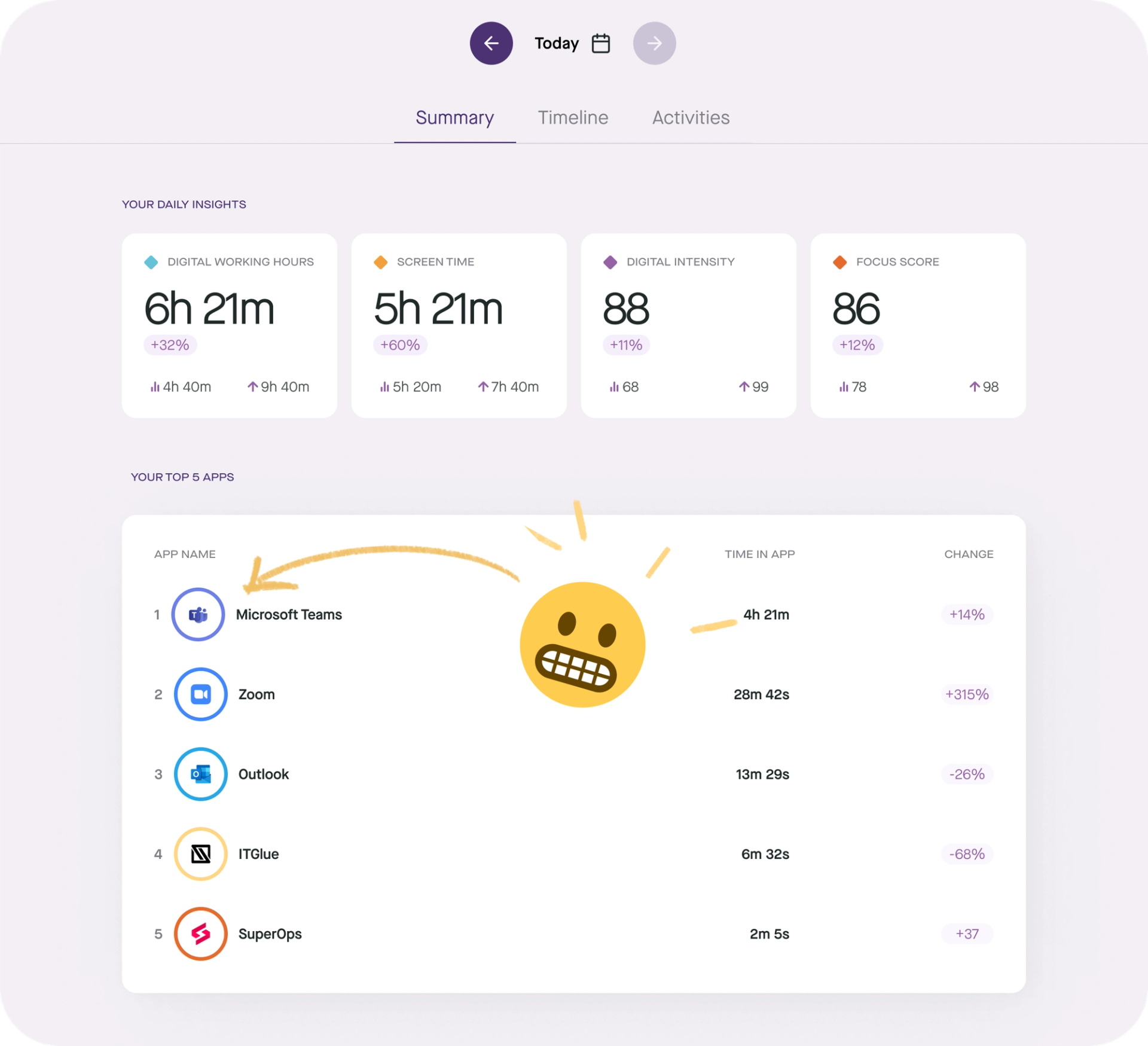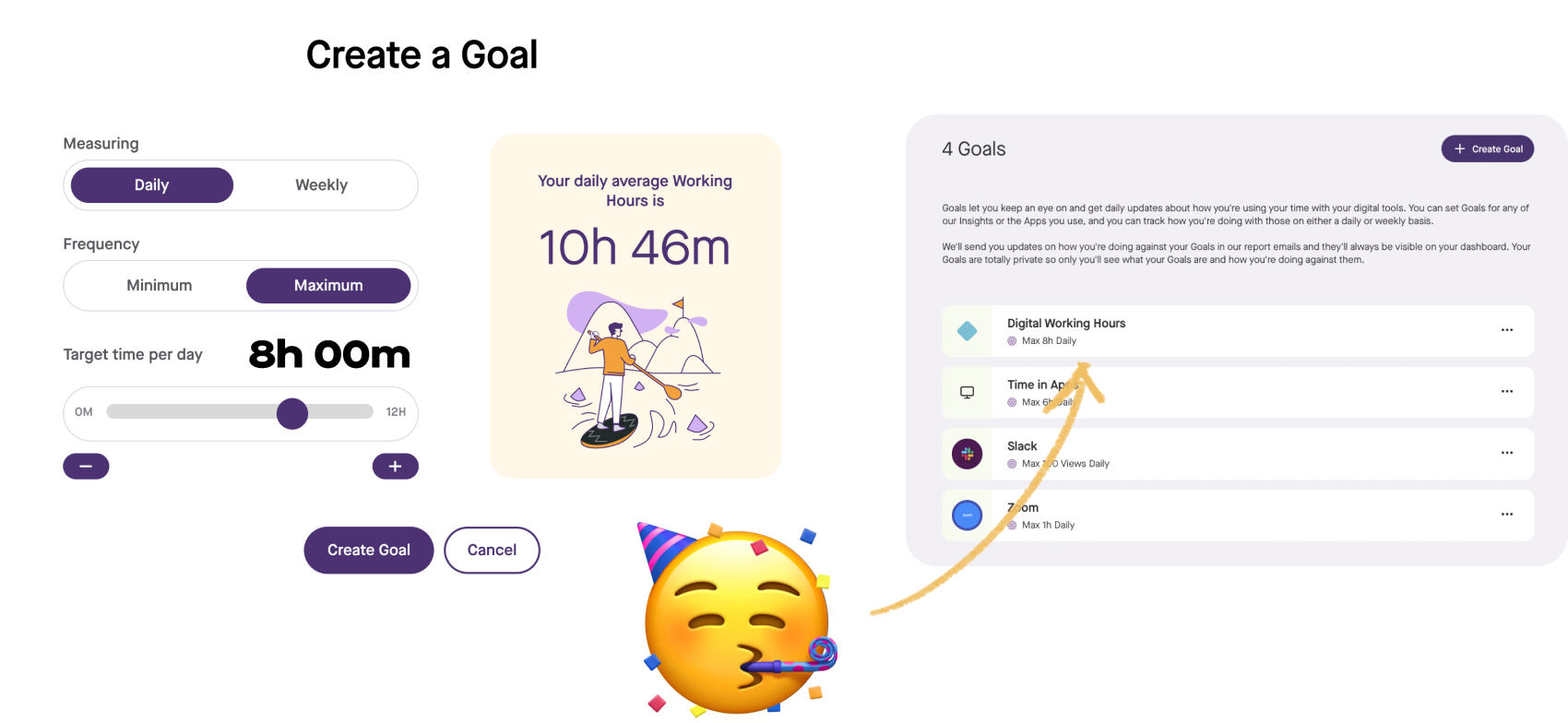Digital Work Analytics reporting
We all want our teams to perform at their best. But many teams and individual workers are not achieving the workdays they want.
Several factors can make work less than ideal, including lack of direction, lack of empowerment, long hours, and having too many tasks. These problems compound and lead to burnout.
The prevalence of employee burnout is concerning, as highlighted by a Mental Health America and FlexJobs study in which 76% of respondents acknowledged that workplace stress impacts their mental health and 75% reported experiencing burnout.
The statistics on burnout serve as a crucial warning for all business leaders, regardless of their stance on the issue. Burnout can lead to lost time, declining health, insufficient support, and even financial implications for the organization's bottom line. For instance:
- Burnt-out workers are 63% more likely to call in sick and over twice as likely to hunt for a new job.
- Around 31% of workers feel anxious trying to meet unrealistic work targets, making them feel ineffective in their roles.
- Workplace stress costs the U.S. economy a whopping $500 billion , leading to the loss of 550 million workdays yearly.
Burnout doesn’t happen overnight—it’s the result of unaddressed issues persisting over time. But if leaders act without understanding the root causes of burnout and implement changes without tailoring solutions to their team's workstyles, they risk exacerbating the situation.
To make improvements, we must first understand what in the workday causes burnout. Then we must establish a shared understanding of the workday and make changes that prevent those unhealthy factors from negatively impacting your team.
The leading indicators of burnout
While burnout progresses slowly, it does leave signs. Recognizing them at an early stage can prevent things from escalating.
Knowing the leading indicators of burnout enables individuals to take proactive steps for prevention. This can empower them to bring the data to their leaders and find a solution before exhaustion and prolonged stress become unmanageable.
For leaders, seeing these signs helps establish support systems within organizations. It enables managers and leaders to be open to making changes to company policies. It also helps foster a work environment that encourages open communication and provides resources to prevent burnout among teams.
Almost 70% of professionals, according to Deloitte's research , feel that their employers aren't doing enough to prevent or reduce burnout at work. So, working closely with your team to identify work habits and behaviors that lead to burnout can help someone who is suffering make the changes.
But which changes should you make first? And how can you tell if those changes are working?
Produce8 is like a health tracker for your workday. We provide data to empower individuals, teams, and leaders so they can take back control of their time and prioritize their well-being.
Book a demo with our team and we will set you up to start understanding your workday.
How to use Produce8 to identify burnout
Produce8 shows individuals and teams how they use their technology and time.
While the tool cannot fix a toxic work culture directly, it does build the space needed to have bigger conversations by identifying work-related factors that commonly lead to burnout.
To start, get your baseline data (your initial set of measurements that will give you insights into your work habits). Once you have this data, here’s what to look for:
Leading burnout indicator #1: excessive overtime or missed breaks
Workers who experience burnout typically skip breaks or work extra hours. This lack of downtime deprives them of the opportunity to recharge, leading to increased fatigue, reduced productivity, and diminished cognitive function. Over time, the cumulative effects can lead to chronic stress, decreased job satisfaction, and an inability to maintain a healthy work-life balance.
In Produce8, you can easily see your Digital Working Hours, Time In Apps, and Digital Intensity Scores. This data gives you a good idea of how long you spend at your desk working.

When we see that an employee is regularly working long hours in the Timeline, it’s important to provide some support, assist in prioritization, and encourage rest and recovery.

Leading burnout indicator #2: context switching
Constantly shifting focus demands mental effort and increases cognitive load. This in turn leads to reduced efficiency and productivity.
Over time, this continuous context-switching can lead to mental exhaustion , heightened stress levels, and a feeling of being overwhelmed, all of which ultimately contribute to burnout.
In the Produce8 Timeline, we see context switching occur in the form of interactions between several different work tools that aren’t connected to the task you want to concentrate on.

For example, we see Rob performing three different tasks with no structure. He’s using Bamboo and LinkedIn for recruiting, Google Docs to work on a blog post, and Teams and Outlook for collaboration.
Leading burnout indicator #3: collaboration overload
Collaboration is indeed essential. But relying too heavily on communication platforms can lead to a constant stream of messages, meetings, and notifications.
According to Zapier, 90% of workers spend up to five hours a day in chat apps like Slack and Microsoft Teams.
This constant interaction often leads to heightened stress, decreased productivity, and a sense of being constantly on edge in workers. Over time, this overload can lead to burnout as individuals struggle to balance collaborative demands with their need for uninterrupted work and personal space.
In Produce8, you can see how many hours a week you spend using collaboration tools. Time spent using these tools is time and energy not spent on more important tasks. This contributes to stress and increased pressure.

Next steps: set goals in Produce8
Managing burnout requires dedication. There will be periods when the business and team need an individual to put in extra effort, but it’s important to not overlook the potential harm that overextending would do to their work, health, and the company’s ROI .
To ensure your team can better manage the ebb and flow of daily work, empower them with data. Doing so enables them to take control of their day by setting their own goals and having some autonomy over how hard to push themselves.

It all begins with comprehension, followed by fostering an environment that encourages open communication among team members. This approach allows us to tackle issues without assigning blame to individuals, thereby preventing burnout.
Don’t wait until burnout happens. Sign up for Produce8 and start identifying your work habits now.
Related Aritcles
Digital Work Analytics reporting
Produce8 Launches Essential Insights: Revolutionizing Digital Work Analytics for Businesses and MSPs
3 min read
Unlock great workdays
Wether you are collaborating with your team or solo tackling your day we can help you recover the most valuable asset, time.
